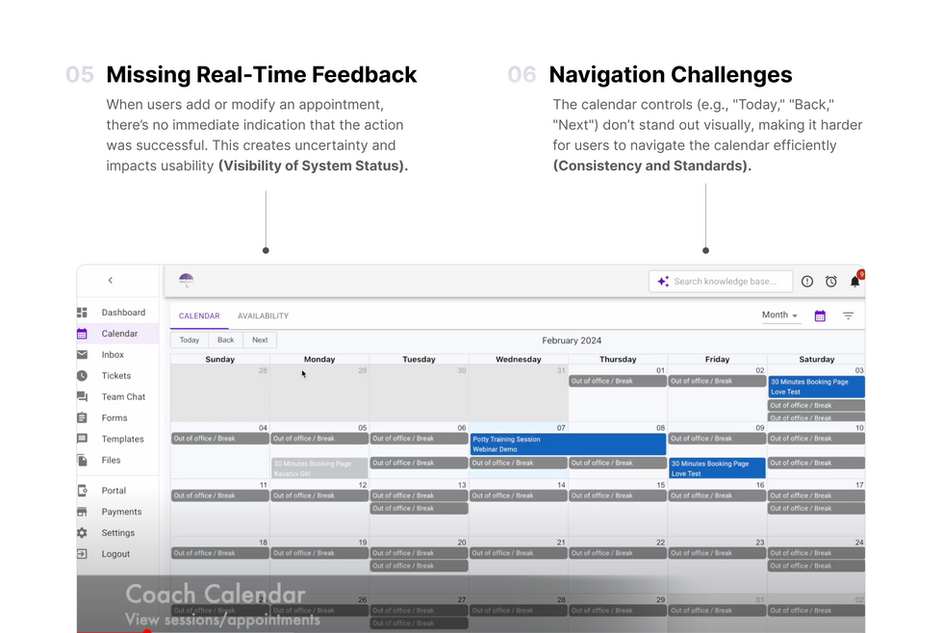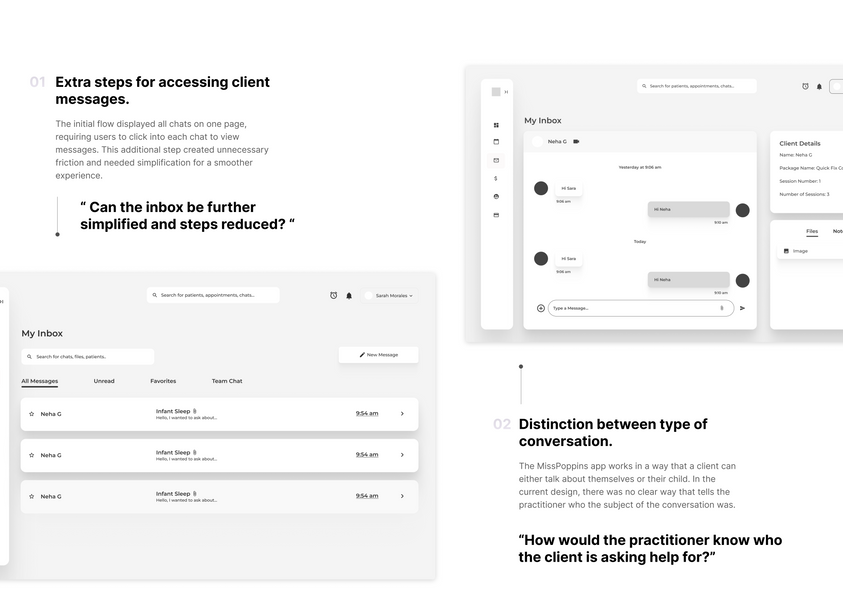top of page

tl;dr
MissPoppins is a marketplace platform connecting licensed parenting practitioners—like lactation, nutrition, and sleep coaches—with parents at every stage, from pre-pregnancy to toddlerhood, making support accessible and affordable.
Who are the users?
Parents
Parents in pre-pregnancy, pregnancy, and toddlerhood can book consultations, access resources, and join webinars through the app.
Practitioners/Coaches
Licensed professionals such as lactation consultants, nutritionists, doulas, and sleep coaches.
The Problem
The practitioner dashboard used by MissPoppins, powered by Tellescope, was overly complex and unintuitive, leading to missed appointments, delayed client responses, and inefficient task management.
Impact Metrics

Note: The impact metrics were observed after 6 weeks of real-world use by practitioners, through Mixpanel Analytics.
How did I approach the problem?
The Process

phase 01
Research
User Interviews

Contextual Inquiry
Heuristic Evaluation
navigating through challenges
Understanding constraints
Before diving into research, there were certain constrains that were highlighted by stakeholders.
HIPAA Compliance
Ensuring the new internal dashboard complied with HIPAA regulations was a non-negotiable requirement.
Tight deadlines
There was an urgency for the product as delays were no longer an option- the existing system was negatively impacting business performance.
Limited Resources
As Tellescope was a third-party tool, I couldn’t interact with it firsthand, relying instead on observations & dashboard demo videos.
why is this important?
Let's dig deeper into the problem
MissPoppins used Tellescope, a third-party dashboard, for practitioners to manage appointments and clients. While HIPAA-compliant, the tool was overwhelming and inefficient, with cluttered information and confusing workflows. Practitioners struggled to keep up, leading to missed appointments, delayed responses, and frustration.
Key Metrics from Mixpanel
4 minutes avg. task time
to perform key actions like scheduling or managing appointments.
82%
session completion rate, well below the target of 95%.
3x slower
coaches’ response times to client inquiries, impacting client satisfaction.
10/10
practitioners reported frustration with dashboard usability in feedback surveys.
setting a clear direction
Strategy for Research
Before starting research, I created a user story to align decisions with practitioners' needs and MissPoppins' business goals, ensuring a focused design process.
User Story
"As a practitioner, I want to easily navigate the dashboard so I can manage my clients and appointments without delays or confusion.."
Key Questions
What key information do they need most?
What’s slowing practitioners down?
user interviews
What key information do they need most?
To understand what information they valued most, I conducted interviews with all 10 practitioners across six specialties. These conversations revealed their frustrations and the inefficiencies they faced daily, including:
Key Frustrations
Hear it from the users
Lack of clarity in appointment details
Practitioners wanted clear session details to prepare for appointments but couldn’t easily access them in the current setup.
Payment Uncertainity
Practitioners felt unsure about client billing status & details due to unclear organization of information & lack of transparency.
Delayed Notifications
Notifications sent via email were delayed, leading to missed appointment confirmations, reminders, and chat updates.
Overwhelmed by clutter
The dashboard displayed data from other providers, distracting practitioners and increasing cognitive load.
“Finding key information takes forever. It’s like hunting for a needle in a haystack...”
- Sara Morse, Certified Pediatric Sleep Consultant
contextual inquiry
What's slowing practitioners down?
I observed their workflows via Zoom to understand what slowed them down and to dig deeper into how practitioners navigated the dashboard. By watching them complete tasks in real-time, I identified bottlenecks like:
Key Challenges
4 minutes avg. task time
Practitioners took an average of 4 minutes to complete simple tasks like scheduling appointments, with multiple unnecessary clicks.
Missing communication features
No tools for file sharing and screen sharing during video consults made client communication slow and inefficient.
Irrelevant information causing distractions
They struggled to distinguish between important and irrelevant information, such as data from other providers cluttering the interface.
heuristic evaluation
Diagnosing usability issues
After conducting user interviews and contextual inquiries, I wanted to further validate the usability issues practitioners were experiencing with the Tellescope dashboard. Since I didn’t have direct access to the live dashboard, my evaluation was based on a recorded demo video provided by the team.
I identified critical pain points with the help of NN Group's 10 Usability Heuristics, combined with insights gathered from contextual inquiry.
phase 02
Define

Affinity Mapping

Product Strategy
.png)
User Goals
defining the goals
The Main Challenge
Summarizing all research insights into a central guiding question.
Core Challenge
Immediate goals for users
"How might we create a personalized, intuitive dashboard that enables practitioners to efficiently manage their clients, access relevant information easily, and improve communication workflows?"
Quick Access to Key Information
View client schedules, appointment details, and relevant data without unnecessary steps.
Personalized Dashboard
Tailor the dashboard experience to show only the information that matters most to each practitioner.
Streamlined Communication
Provide tools for seamless communication with clients, such as chat, notifications, and file-sharing features.
This was the first internal dashboard for practitioners at MissPoppins. It was important to also understand that the users weren't too tech-savvy and prioritized achieving their goals in the fastest and easiest way possible.
Design goals
Improved Usability
A clean, easy, intuitive interface that minimizes confusion and reduces cognitive load.
Streamlined Workflows
Simplify repetitive tasks like managing appointments and communicating with clients.
balancing user and business needs
Product Strategy
Given the tight three-week timeline, I needed to balance urgency and quality. I took an MVP-first approach that allowed us to address critical needs quickly. This ensured that practitioners could continue serving clients effectively while leaving room for incremental improvements over time.
Strategy

Key Success Metrics
Session Completion rate
Increase completed sessions from 82% to the target of 95%.
Practitioner Satisfaction
Improve satisfaction scores via post-implementation surveys.
Error Reduction
Decrease missed or delayed appointments caused by usability issues.
phase 03
Ideation
Sketches
Moscow Analysis
Lo-fidelity wireframes
ideation approach
Prioritizing must-haves & should-haves
I began by brainstorming ideas to address practitioner pain points, then collaborated with stakeholders to prioritize features for the MVP.

giving form to the ideas
Rough Sketches
With the MVP features defined, I created initial sketches, that focused on must-haves & should-haves.

using sketches as a guide
Sketches to low-fidelity wireframes
I created low-fidelity wireframes, involving stakeholders and engineers early on for feedback on technical feasibility and business alignment.
Here's some of the key feedback received.
phase 04
Design, Deploy, Test & Iterate
High Fidelity Prototypes
Usability Testing
bringing the vision to life
Launching Motherboard (MVP)
Once I refined the designs based on feedback, I opted to defer usability testing given the timeline until after the MVP was shipped to gather practitioner feedback, enabling iterative improvements post-launch.
After launching the MVP, I conducted moderated usability testing with all 10 practitioners to gather feedback and address usability concerns.
Hear it from the users
“The new dashboard is so clean, beautiful and easy to navigate. Everything I need is right there—no extra steps, no confusion.”
- Cerina Butler, Certified Pediatric Nutrition Consultant
iterating beyond the MVP
Key iterations and final designs
With insights from usability testing, I refined the MVP further and we added advanced features, enhancing navigation, task efficiency, and communication tools.
Additional HIPAA Compliance Enhancements
Data Encryption
Protected sensitive client data with industry-standard encryption.
Role-Based Access Control
Ensured practitioners could only access relevant patient information.
Secure Notifications
Removed personal health details from alerts to prevent accidental data exposure.
Note: Sensitive patient data has been replaced with mock data in the designs for HIPAA compliance. This is what Motherboard looks like today, live and shipped.
retrospection
What I would do differently today
I’d Involve Practitioners Earlier in the Design Process
While the final solution addressed many pain points, I realized involving practitioners earlier in ideation could’ve uncovered deeper insights. Next time, I’d co-create with them from the start to ensure every design decision directly aligns with their needs.
I’d Test Iterations with Real-World Scenarios
Usability testing focused on task efficiency, but real-world scenarios could’ve revealed edge cases and hidden challenges. Moving forward, I’d simulate real workflows during testing to design solutions that hold up under actual use.
looking back
Key takeaways and reflections
Adapting to the Startup Mindset
Working in a startup environment pushed me to think beyond just design. I had to balance creativity with practicality, making quick, informed decisions while aligning with business goals. This experience taught me the importance of agility and adaptability in delivering impactful solutions under tight timelines.
Embracing Ownership in Design
As the sole designer, I had the opportunity to own the end-to-end process—from research to delivery. This role strengthened my ability to work independently, trust my instincts, and wear multiple hats. It reinforced my confidence in taking on challenging projects and delivering meaningful results.
Anchor 1
bottom of page













